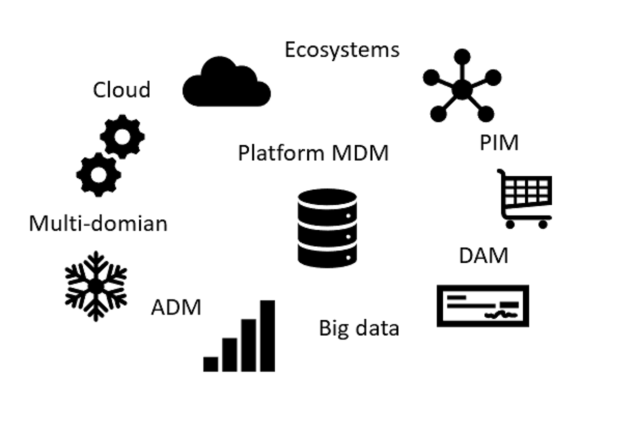Master Data Management (MDM) can take many forms. An exciting side of being involved in MDM implementations is that every implementation is a little bit different which also makes room for a lot of different technology options. There is no best MDM solution out there. There are a lot of options where some will be the best fit for a given MDM implementation.
The available solutions also change over the years – typically by spreading to cover more land in the MDM space.
In the following I will shortly introduce the basic stuff with seven flavours of MDM. A given MDM implementation will typically be focused on one of these flavours with some elements of the other flavors and a given piece of technology will have an origin in one of these flavours and in more or less degree encompass some more flavors.

The traditional MDM platform
A traditional MDM solution is a hub for master data aiming at delivering a single source of truth (or trust) for master data within a given organization either enterprise wide or within a portion of an enterprise. The first MDM solutions were aimed at Customer Data Integration (CDI), because having multiple and inconsistent data stores for customer data with varying data quality is a well-known pain point almost everywhere. Besides that, similar pain points exist around vendor data and other party roles, product data, assets, locations and other master data domains and dedicated solutions for that are available.
Product Information Management (PIM)
Special breed of solutions for Product Information Management aimed at having consistent product specifications across the enterprise to be published in multiple sales channels have been around for years and we have seen a continuously integration of the market for such solutions into the traditional MDM space as many of these solutions have morphed into being a kind of MDM solution.
Digital Asset Management (DAM)
Not at least in relation to PIM we have a distinct discipline around handling digital assets as text documents, audio files, video and other rich media data that are different from the structured and granular data we can manage in data models in common database technologies. A post on this blog examines How MDM, PIM and DAM Stick Together.
Big Data Integration
The rise of big data is having a considerable influence on how MDM solutions will look like in the future. You may handle big data directly inside MDM og link to big data outside MDM as told in the post about The Intersection of MDM and Big Data.
Application Data Management (ADM)
Another area where you have to decide where master data stops and handling other data starts is when it comes to transactional data and other forms data handled in dedicated applications as ERP, CRM, PLM (Product Lifecycle Management) and plenty of other industry specific applications. This conundrum was touched in a recent post called MDM vs ADM.
Multi-Domain MDM
Many MDM implementations focus on a single master data domain as customer, vendor or product or you see MDM programs that have a multi-domain vision, overall project management but quite separate tracks for each domain. We have though seen many technology vendors preparing for the multi-domain future either by:
- Being born in the multi-domain age as for example Semarchy
- Acquiring the stuff as for example Informatica and IBM
- Extend from PIM as for example Riversand and Stibo Systems
MDM in the cloud
MDM follows the source applications up into the cloud. New MDM solutions naturally come as a cloud solution. The traditional vendors introduce cloud alternatives to or based on their proven on-promise solutions. There is only one direction here: More and more cloud MDM – also as customer as business partner engagement will take place in the cloud.
Ecosystem wide MDM
Doing MDM enterprise wide is hard enough. But it does not stop there. Increasingly every organization will be an integrated part of a business ecosystem where collaboration with business partners will be a part of digitalization and thus we will have a need for working on the same foundation around master data as reported in the post Ecosystem Wide MDM.